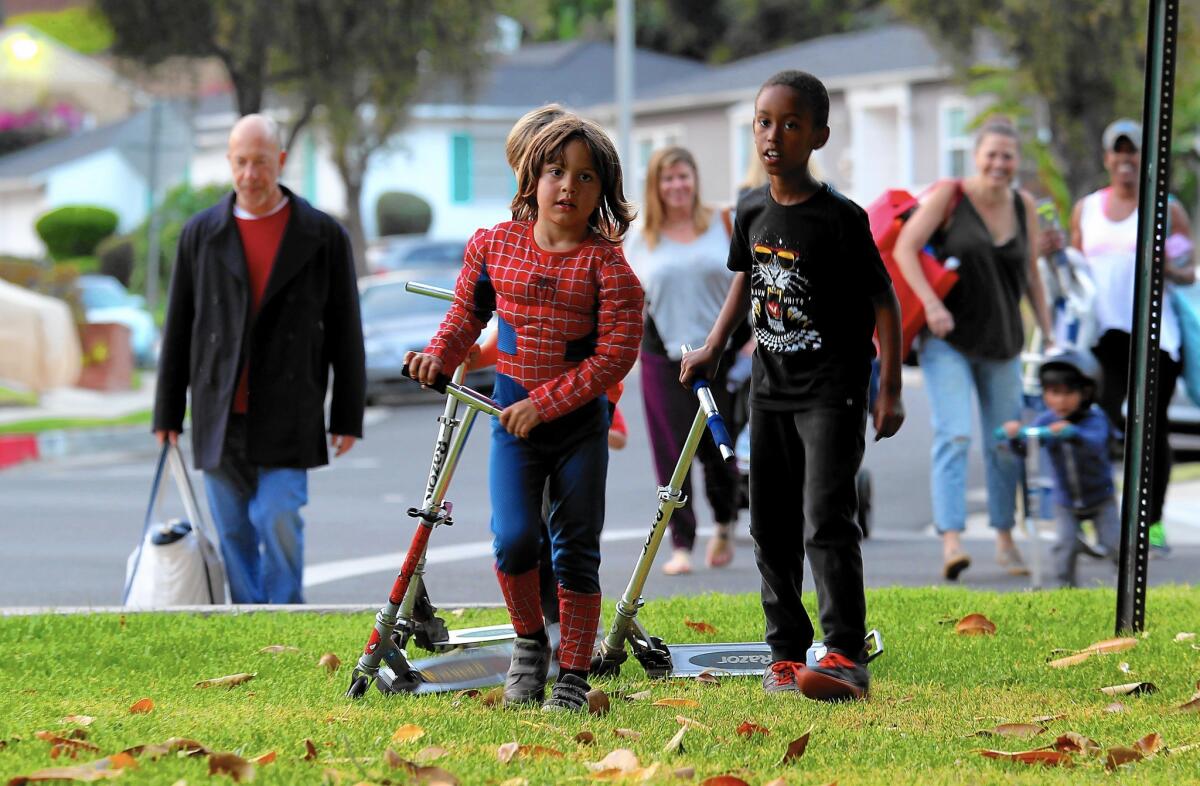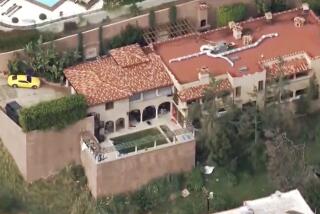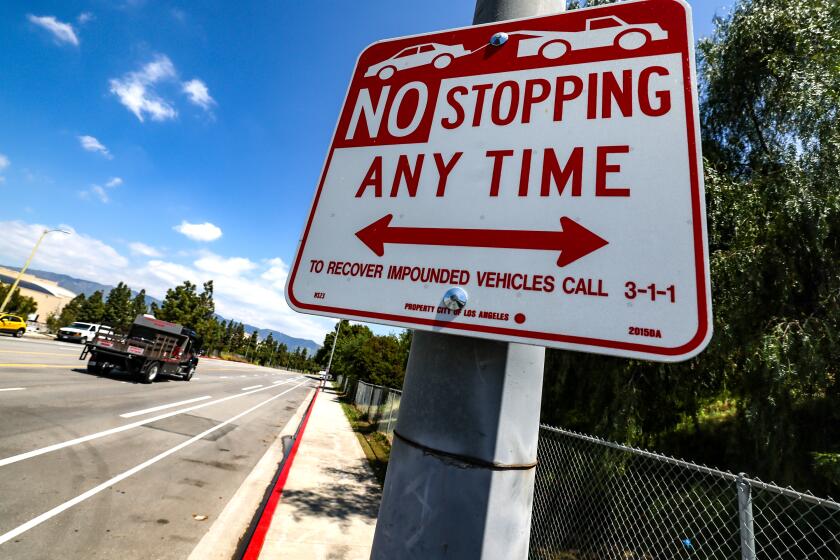‘Black Beverly Hills’ debates historic status vs. white gentrification

Longtime residents of View Park have a thinly veiled code for the signs of change they see in their upscale neighborhood: “joggers” ... “dog walkers.”
“It’s like an alien sighting,” says Karen Martin, who grew up in this hilltop community framed by La Brea Avenue and Crenshaw Boulevard. “We never saw them before.”
But now they are back. White people. With fluffy dogs. And fluorescent Spandex.
And for some longtime residents who cherish View Park as a symbol of African American success and a stronghold of black culture, that’s unsettling.
SIGN UP for the free Essential California daily newsletter >>
Residents of View Park, with its curving, palm-lined streets, stunning views and movie star quality homes, have for decades fought any proposal that they thought threatened their neighborhood’s special qualities — including its solid sense of African American identity.
Now a move that strikes many as an accolade — an effort to put View Park on the National Register of Historic Places — has blown up into a particularly contentious fight.
Some residents covet this honor for a community whose proud past is part of what makes it feel like home.
Others fear that the designation is a ploy to lure in white buyers who can no longer afford to turn up their noses at black neighborhoods now that Westside real estate has gone through the roof.
Tammy Williams, for example, practically radiates community pride — but opposes the historic designation.
She graduated from Cal State Dominguez, married into a monied family, bought a starter home and, in 2003, finally worked her way up to an area some call the “Black Beverly Hills.”
When she moved into her 4,000-square-foot Mid-century Modern on a spacious corner lot, the woman who sponsored her as a teenage debutante proclaimed: “You have arrived.”
Later, Williams says, she and a friend stood on her new neighbor’s patio, feeling like Huxtables as they basked in the downtown skyscrapers’ evening glow. “We’ve made it!” Williams whooped.
In a way, she was speaking not just for herself but for African Americans more generally.
View Park was largely white into the 1960s. Then the Supreme Court lifted covenants that barred nonwhite homeowners, and the first wave of prosperous black families — lawyers, doctors and businesspeople — began to integrate the neighborhood.
As blacks moved in, whites fled, leaving 2,500- to 5,000-square-foot homes, some with maid’s quarters, pools and backyard views of downtown, Hollywood and the Pacific.
At a time when places such as Brentwood and Bel-Air made it clear that blacks were not welcome, entertainers including Ray Charles, Ike and Tina Turner, and dance/choreographer Debbie Allen flocked to View Park. Actress Loretta Devine and former Lakers star Michael Cooper still call it home.
By the 1970s, blacks outnumbered whites nearly 3 to 1. A decade later, the ratio was 9 to 1.
Today, this unincorporated neighborhood of 1,700 custom homes is 84% African American, and, combined with neighboring Windsor Hills, Baldwin Hills and Ladera Heights, constitutes the West Coast’s highest concentration of black affluence.
Half of View Park’s residents have earned a bachelor’s degree or higher, according to the 2010 census, and the tract that contains most of the neighborhood had an average family income of $90,000 — tens of thousands of dollars above the countrywide average for white families and 21/2 the median income among Los Angeles County blacks.
Some residents say that it’s because individuals and blacks as a group had to work so hard to win a place atop this hill that they fight so hard to maintain its character.
When urban planners decided to build low-income apartment buildings at the bottom of the hill, a group of residents defeated the plan. Residents blocked an effort to put restrooms in the local park because of fears that they would attract nuisances. Some have resisted the Crenshaw-LAX light-rail line out of concern that it will bring new people to the base of their quiet domain.
One group of residents says that it is this same concern of outsiders moving in and altering the cultural and architectural character of View Park that inspired them to band together as the View Park Conservancy and nominate their neighborhood as a historic district on the National Register of Historic Places.
That federal designation could come with property tax credits for new homeowners who maintain a property’s historic characteristics and limited federal protection from development projects, National Register historian Paul Lusignan said.
Many residents say they welcome any change that makes their homes more valuable.
A determined group of opponents, however, accuse outside developers and house flippers of trying to snap up the homes of residents who have run into financial problems. The plan, they say, is to use the historic designation as a marketing tool to attract a new — and largely white — crop of buyers to View Park’s historic homes, some built by famed architects, that often sell for hundreds of thousands less than those with comparable features a few miles west.
“Somebody found a gold mine and they are trying to milk it,” says musician Reggie A. Carson, 49. “Seniors happen to be the predominate demographic here and they are also the easiest to get rid of.”
Ben Kahle, one of the conservancy’s co-founders and a licensed real estate agent, did nothing to allay such concerns by posting a few of his thoughts about View Park in an online forum.
“My plan is to walk my dogs around . . . meet as many neighbors as I can, and to be seen as a friendly face,” he said in the 2013 post. “When the time comes, I’m thinking of having my wife bake some of her amazing cookies ... and mention that I’d be interested in buying their homes.”
As Kahle sat under the vaulted ceiling of his 1920s Spanish home, his voice cracked and tears rimmed his eyes as he described the joy of uncovering the neighborhood’s rich history over the last two years. But his body stiffened when discussing the online post.
Later, by phone, he said he regrets his comments.
“I definitely understand the concerns that people would feel after reading some of those things,” he said, adding that he does not intend to do anything that would hurt the neighborhood.
View Park is hardly alone in its identity crisis.
From Washington, D.C., to Oakland, working-class neighborhoods that have been strongholds for blacks are becoming increasingly diverse as people shun suburbs for the convenience of city living, says Darrick Hamilton, an associate professor of urban policy at The New School in Manhattan.
So far, the trend has skipped many more prosperous African American neighborhoods, such as those in Prince George’s County, Md., where buyers as well as sellers continue to be predominantly black.
But several factors, including the recession’s lingering effect on African Americans and Los Angeles’ raging real estate market, could well make places such as View Park an exception.
Some black homeowners grabbed the low, adjustable interest loans that subprime lenders dangled before them to refinance their homes, researchers say.
Some used the equity in their homes as a down payment on other middle-class dreams such as business ventures, private schooling and investment properties.
Some fell behind on payments and their homes ended up in foreclosure. This occurred much more frequently in black communities, said Lance Freeman, a professor of urban planning at Columbia University and author of “There Goes the ‘Hood: Views of Gentrification From the Ground Up.”
According to a recent Zillow study, blacks are denied home loans at twice the rate of whites, and so it is more likely that banks, flippers and non-African American buyers will grab those foreclosed properties.
These and other forces have contributed to an overall drop in Los Angeles’ black population, from 17% in the 1970s and 1980s to 9.6% in 2010.
Author and analyst Earl Ofari Hutchinson, who lives in Windsor Hills, says that he understands why some of his View Park neighbors are sensitive to the arrival of new white residents — including those joggers and dog walkers.
“We have so few areas,” he says. “So little turf that we can call our own. This is yet another invasion by another group coming in to destroy both the culture, the lifestyle and the economic continuity of our area.”
But conservancy co-founder Andre Gaines says his group’s roster of 476 members shows it has the backing of the community.
It took the group less than a year to hit its fundraising goal of $100,000. Some of that money, Gaines said, will pay for the firm Architectural Resources Group to complete the documentation needed for the National Register nomination, including maps, photos and descriptions of each property.
The firm recently sent out two white women carrying laptops and cameras to go house-to-house gathering information. A few angry residents hurled expletives from their cars.
“There were definitely tense moments, but that’s not uncommon,” said Katie Horak, a principal of the research group. “People get protective of their homes, as they should.”
For their part, opponents have passed out fliers calling attention to a website, StopGentification.org. The home page offers this warning: “Historic preservation has been transformed into a real estate gimmick to start the gentrification process.”
In a Facebook discussion of the controversy, one opponent warned the conservancy that “View Park will not be colonized. . . I’m coming at you with FULL FORCE!!!!!!!”
The conservancy hired security for its next fundraising event.
Williams, the resident who considered her move to View Park as her moment of arrival, carries a three-ring binder bulging with battles that View Park residents had to fight over the decades.
She’s also set up another website, View Park Arts & Cultural Foundation. One page features posters of films that were shot there, including “Ray,” “Love and Basketball,” “What’s Love Got to Do With It,” and “Something New.”
Together, the films tell the distinctly African American stories. View Park residents on all sides of the historic designation debate say that such stories make them proud and protective of the place they call home.
“You make the black people disappear and its breaks the legacy for the next group who earned their way back to this community,” Williams said. Those pushing for historical designation, she added, “are only interested in the real estate. They are not looking at the people.”
Conservancy member Cookie Parker, 72, disagrees. The neighborhood’s growing diversity, including an influx of young people, is healthy for everyone, she says. “There’s a vibrancy. Every place needs new life and new blood.”
Times staff writer Sandra Poindexter contributed to this report.
ALSO:
Boyle Heights residents force a fresh start on Mariachi Plaza project
Lost in translation: Hip nickname for South L.A. leaves some feeling lonely
L.A. suit accusing Wells Fargo of predatory mortgage lending practices is dismissed
More to Read
Start your day right
Sign up for Essential California for news, features and recommendations from the L.A. Times and beyond in your inbox six days a week.
You may occasionally receive promotional content from the Los Angeles Times.







